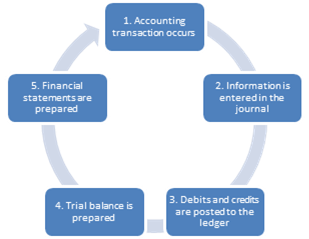
Concept explainers
(a)
The Accounting Information System is a system that a business uses for collecting, storing, and processing the data of the accounting transactions and provides the financial information to the decision makers.
Accounting information cycle:

Figure (1)
To indicate: The proper flow of accounting information, as Person B is confused about the accounting information flows.
(b)
To indicate: The proper flow of accounting information, as Person B is confused about the accounting information flows.
(c)
To indicate: The proper flow of accounting information, as Person B is confused about the accounting information flows.
(d)
To indicate: The proper flow of accounting information, as Person B is confused about the accounting information flows.
(e)
To indicate: The proper flow of accounting information, as Person B is confused about the accounting information flows.
Want to see the full answer?
Check out a sample textbook solution
Chapter 3 Solutions
FINANCIAL ACCOUNTING: TOOLS FOR BUSINES
- When preparing the trial balance, the accountant of Zenith Co. noticed that the debit column exceeded the credit column by $1,000. Which of the following errors could cause such an imbalance? A) A transaction not recorded at all B) Reversing the debit and credit C) Posting an amount twice to the debit side D) Recording a sale as a purchase MCQarrow_forwardI am looking for the correct answer to this general accounting question with appropriate explanations.arrow_forwardDon't use AIarrow_forward
- General accountingarrow_forwardWhat are the required sales?arrow_forwardLuma Corp. had net credit sales of $2,400,000 in 2023. The beginning accounts receivable balance was $180,000, and the ending balance was $210,000. (a) What is the receivables turnover? (b) What is the average collection period in days?arrow_forward
- What is the desired profit for the year?arrow_forwardWhat is the absorption costing unit product cost?arrow_forwardWhich financial statement shows the financial position of a business at a specific point in time? This statement includes assets, liabilities, and owner’s equity. A. Balance Sheet B. Statement of Cash Flows C. Trial Balance D. Income Statementarrow_forward
 Auditing: A Risk Based-Approach (MindTap Course L...AccountingISBN:9781337619455Author:Karla M Johnstone, Audrey A. Gramling, Larry E. RittenbergPublisher:Cengage LearningPrinciples of Accounting Volume 1AccountingISBN:9781947172685Author:OpenStaxPublisher:OpenStax College
Auditing: A Risk Based-Approach (MindTap Course L...AccountingISBN:9781337619455Author:Karla M Johnstone, Audrey A. Gramling, Larry E. RittenbergPublisher:Cengage LearningPrinciples of Accounting Volume 1AccountingISBN:9781947172685Author:OpenStaxPublisher:OpenStax College


